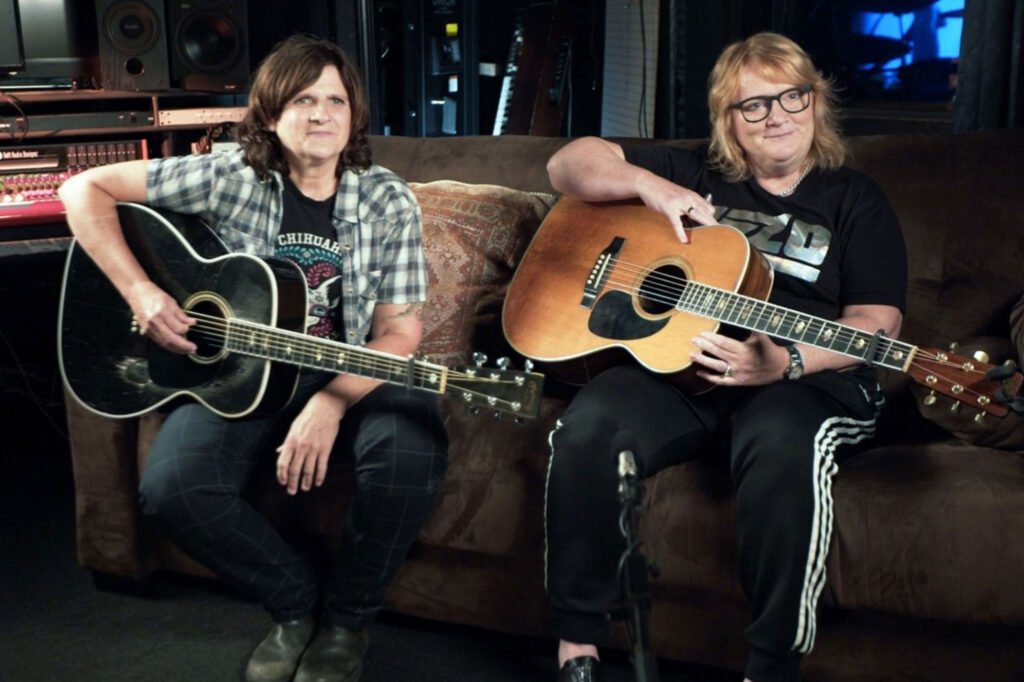March 5, 2023
by Carla Hay

“Mixtape Trilogy: Stories of the Power of Music”
Directed by Kathleen Ermitage
Culture Representation: Taking place in various U.S. cities, the documentary film “Mixtape Trilogy: Stories of the Power of Music” has a racially diverse group of people (white and black with a few of Asian heritage) representing the working-class, middle-class and wealthy telling personal stories of how people are affected by music.
Culture Clash: Some of the fans who are in the documentary talk about sometimes being misunderstood about their passion for certain music or artists.
Culture Audience: “Mixtape Trilogy: Stories of the Power of Music” will appeal primarily to people who are fans of the documentary’s featured artists (Indigo Girls, Vijay Iyer and Talib Kweli) and movies about artists’ connections to their most devoted admirers.

Depending on your interest in the music genres of rock, jazz, classical and hip-hop, “Mixtape Trilogy: Stories of the Power of Music” will either keep you interested or not have much appeal at all. This occasionally uneven documentary mostly achieves what it intended in its title. The first third of the movie is upbeat but predictable. The second third is boring and forgettable. The last third is the most dynamic and informative section of the film.
Directed by Kathleen Ermitage, “Mixtape Trilogy: Stories of the Power of Music” (her feature-film directorial debut) starts off looking like a movie that’s about artists who’ve developed a friendship with a particularly devoted fan of theirs. That’s essentially what viewers see in the first section of the film (featuring folk/rock duo Indigo Girls) and the second section of the film (featuring jazz/classical music composer Vijay Iyer). It isn’t until the third and last section of the film (featuring hip-hop artist Talib Kweli) that this documentary transcends the repetitive scenes of artists and fans gushing over each other, and instead showcases what one fan is doing to incorporate hip-hop music into teaching children about architecture.
In the Indigo Girls section of the movie, a Denver-based superfan named Dylan Yellowlees talks a lot about how much her life revolves around Indigo Girls, whose members are singer/guitarist Amy Ray and singer/guitarist Emily Saliers. Ray and Saliers, who both hail from Georgia’s Atlanta and Decatur metropolitan areas, have known each other since elementary school, and they have been performing together since they were in high school. Indigo Girls’ first album, “Strange Fire,” was released in 1987. At the time this documentary was filmed, Yellowlees said she had seen Indigo Girls in concert more than 350 times. Yellowlees, who describes herself as being in the same Generation X age group as Indigo Girls, also discusses at length how Indigo Girls coming out as lesbians also helped Yellowlees in her own journey of coming out as a lesbian.
Yellowlees, just like many Indigo Girls fans, first discovered Indigo Girls because of the duo’s 1989 breakthrough hit song “Closer to Fine,” from Indigo Girls’ self-titled second album. Yellowlees describes how seeing the “Closer to Fine” video on VH1 made a big impact on her. Yellowlees says she was in college when she first heard “Closer to Fine,” around the same time of the civilian protests that turned deadly in China’s Tiananmen Square. The uplifting lyrics of “Closer to Fine” resonated with her on a deep level and helped give her a political awakening to stand up more for human rights, says Yellowlees. And if anyone cares, Yellowlees reveals that her favorite Indigo Girls song is “Go,” which Ray says in the documentary is a song inspired by feminist writer Meridel Le Sueur.
The documentary’s Indigo Girls section tends to be formulaic in showing Yellowlees attending Indigo Girls concerts and talking about how great she thinks Indigo Girls are. Yellowlees mentions that some people in her life haven’t understood why she spends so much time traveling to various cities to see Indigo Girls perform. Yellowlees comments, “I used to have a boss that was like, ‘I don’t understand why you go and see the same band all the time. Isn’t it the same?'”
Yellowlees continues, “And in his case, he was a fisherman, and he went fishing every weekend. So I was like, ‘You go stand in a river every weekend. Isn’t that the same?’ He’s like, ‘Hey, I understand. It’s the thing that brings me joy.'”
She further explains why Indigo Girls mean so much to her: “Being of the same generation as Indigo Girls, and probably having some shared experiences, it makes that music feel really important. It feels personal. It feels like a part of my life. It feels like it’s part of my story.” And before social media existed, Yellowlees says that going to Indigo Girls concerts was a great way for her to meet other lesbians and queer-friendly people. “Back then, it really was a way to find your people,” Yellowlees comments.
And what do Indigo Girls think of Yellowlees? Ray says that Yellowlees “has become a friend … and is not weird about it. It’s an honest appreciation of what we’re doing.” Saliers (who says she got to know Yellowlees better when Saliers did a solo tour) comments that she’s still amazed that Yellowlees shows the same enthusiasm for Indigo Girls concerts as she has over the several decades that they have been performing. “I feel like it’s an honor that she’s the fan in the way that she is,” Saliers mentions. “She’s smart and interesting.”
Unfortunately, the documentary doesn’t dig much deeper into why Yellowlees is such a special Indigo Girls fan, other than the number of times that she has seen Indigo Girls in concert. A lot of Indigo Girls fans can claim that Indio Girls changed their lives. Ermitage and the other “Mixtape Trilogy” filmmakers needed to show or tell examples of why Indigo Girls consider Yellowlees to be a “friend.”
In a world where celebrities have hangers-on and people who follow them around, what exactly does it mean when Ray says that Yellowlees “has become a friend”? Does that mean a relationship that goes beyond an artist giving free concert tickets to a fan? Do Indigo Girls share private information with Yellowlees, or ask for her advice? The documentary never answers any of those questions and doesn’t give details further details about this friendship
In the documentary’s segment on Iyer, there’s no such ambiguity about the friendship that developed between Iyer and essayist/scholar Garnette Cadogan, who are both based in New York City. Iyer (who has been releasing albums since 1995) describes initially being skeptical and wary when Cadogan approached him for a series of interviews. Both men say in the documentary that these interviews turned into deeply personal conversations about their lives and led to a strong friendship between Iyer and Cadogan.
Iyer says these pivotal conversations, “He got me to a point that no one has ever gotten me, in terms of just being real, just being honest, and basically revealing things that I had never admitted to myself.” Cadogan explains why he became interested in Iyer as an artist and as a person: “He spent a lot of time thinking about, ‘What does this music mean,’ not just as sound but as identity.”
The documentary shows Cadogan spending more time than Iyer does talking about himself and his background. Cadogan calls himself a “man of the streets,” because of his passion for taking strolls on the streets where he lives and travels. Cadogan says he developed this passion when he was a child growing up in Jamaica, where he had an abusive stepfather and a loving mother and grandmother. He would spend a lot of time wandering around streets to avoid going home to the abuse that his stepfather inflicted on him.
Why this segment so dull? Ilyer and Cadogan say that they identify as activists, but the documentary doesn’t really show any of this activism. Instead, there’s just the expected footage of Ilyer performing with his band, and Cadogan sometimes watching as an admiring audience member. It’s all very lackluster and uninteresting.
As a self-described “man of the streets,” Cadogan isn’t shown in the documentary doing any real activism on the streets. Cadogan and Ilyer just seem more like academics who approach things in an intellectual manner but don’t really seem to be in touch with street culture activism. If they are, Cadogan and Ilyer give the impression in this documentary that they keep a safe distance from it.
The documentary’s segment on New York City-based Kweli (whose full name is Talib Kweli Greene) curiously doesn’t show any type of “we’ve become friends” interaction between him and his “superfan” Michael “Mike” Ford, who is an architect. It’s a very disjointed segment where part of it is Kweli talking about his life, while the other part is about Ford talking about his life.
Kweli (who has been releasing music since the late 1990s) is the least candid of the three featured artists in the documentary, because he doesn’t reveal anything that people can’t already find out about him by looking at his Wikipedia page or other information on the Internet. Ford is a fan of Kweli, but he isn’t as obsessive about Kweli as Yellowlees is about Indigo Girls. Ford and Kweli also don’t appear to know each other as friends, based on what’s in this documentary.
The most fascinating and best part of the documentary is how it shows Ford taking his love of hip-hop, doing an analysis of the lyrics, and using that analysis to turn it into architecture models. Ford mentions that when he was growing up in Detroit, he and his sisters discovered hip-hop because their family lived in an apartment above a nightclub that played hip-hop. Ford says that he was about 6 or 7 years old when he became a hip-hop fan.
Ford (who calls himself the Hip-Hop Architect) began a program called Hip-Hop Architecture Camp that he takes to various cities around the United States, in order to teach young people (ranging in ages from 4 years old to late teens) how to use hip-hop in creating architecture. This entertainment/educational program includes the students creating architectural models and their own original hip-hop songs at the end of each program. “Mixtape Trilogy” includes an impressive montage showing clips of music videos that were made of these original songs.
Most of the children who attend Hip-Hop Architecture Camp are underprivileged African Americans. Ford says he saw a need for this program as a way to bring more diversity to people who might become architects someday. “I have never seen something more unifying than hip-hop,” Ford comments in the documentary. Ford also gets candid in “Mixtape Trilogy” about the up-and-down journey that he and his wife, Gail Ford, have had in starting their own family.
“Mixtape Trilogy” has a very good concept that isn’t presented consistently in the documentary’s three segments. A few of the production elements are amateurish, such as in a scene where part of a boom microphone can be seen during an interview, or when the documentary’s sound mixing sounds a little rough. However, this movie does an admirable job of conveying the happiness that people get from the music that is the soundtrack of their lives, as well as showing how that joy and appreciation can be shared with other people.
1091 Pictures released “Mixtape Trilogy: Stories of the Power of Music” on digital and VOD on February 7, 2023.
